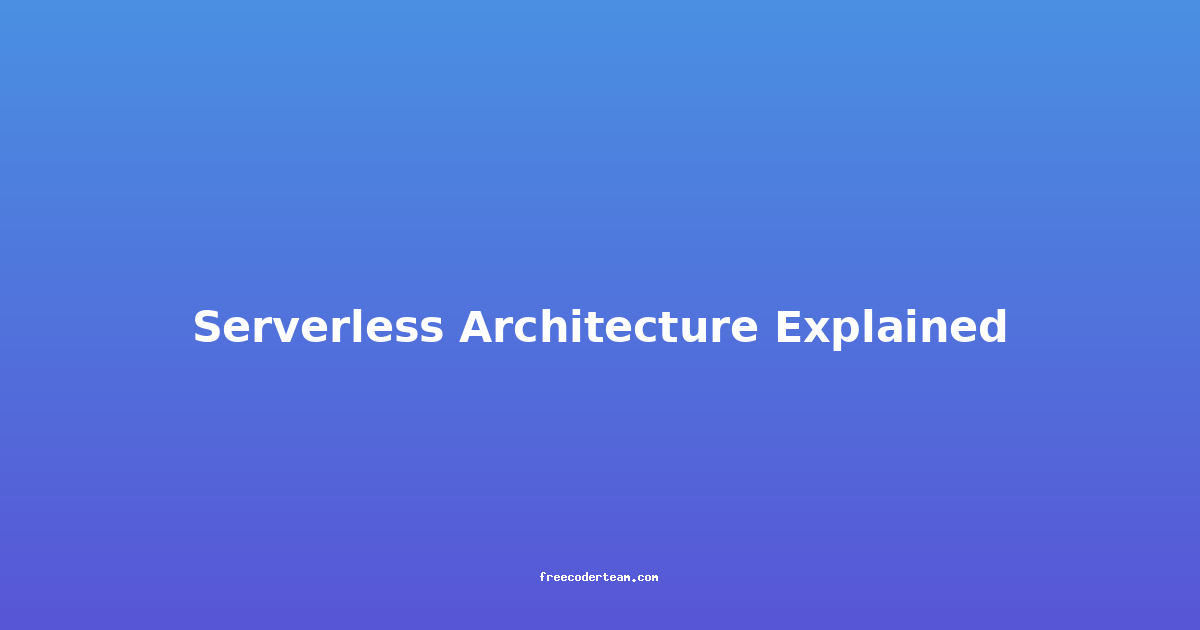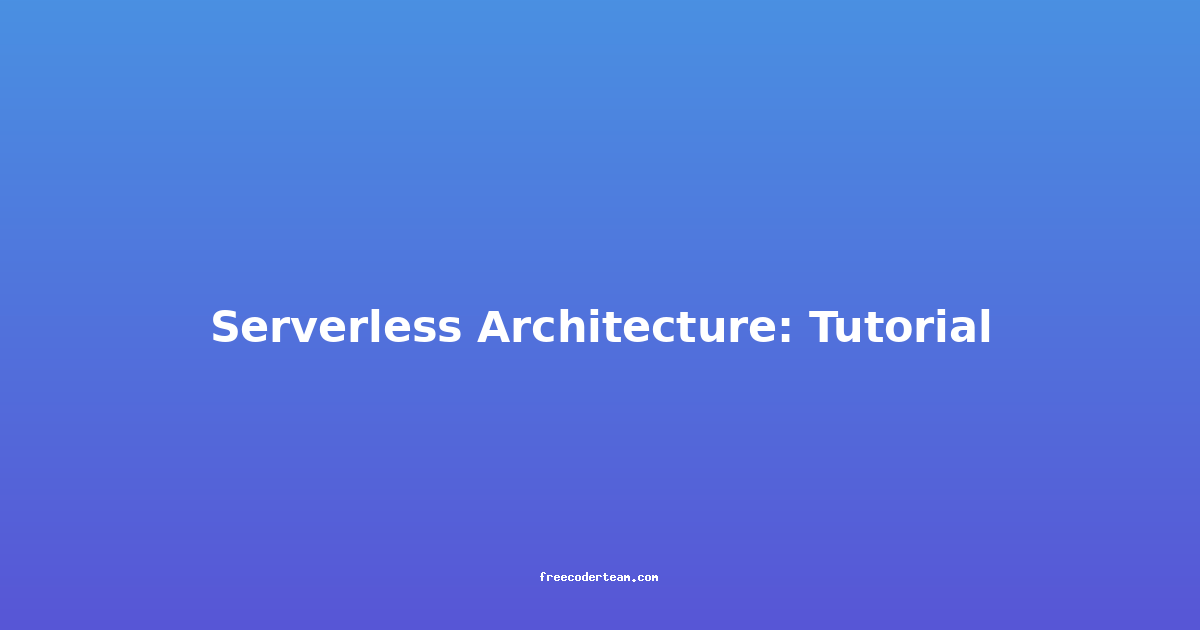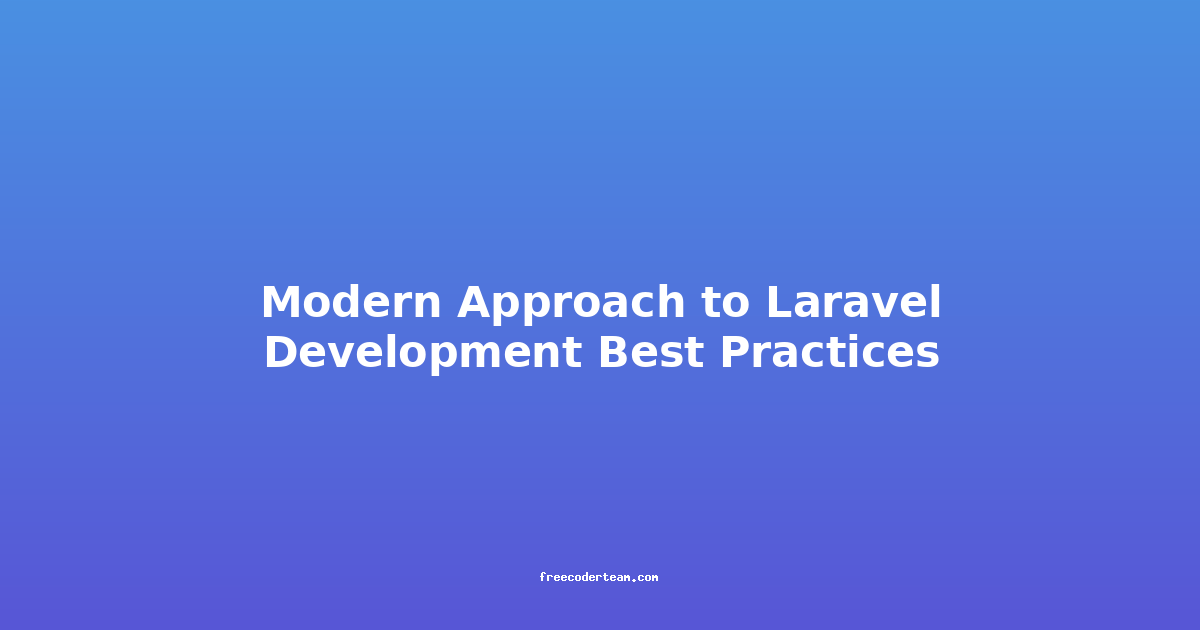Serverless Architecture Explained: A Comprehensive Guide
Serverless architecture has revolutionized the way software is developed and deployed, offering developers a more efficient and cost-effective way to build applications. In this blog post, we'll dive deep into what serverless architecture is, how it works, its benefits, practical examples, best practices, and actionable insights to help you leverage it effectively.
What is Serverless Architecture?
Serverless architecture is a cloud computing model where the cloud provider dynamically manages the allocation and scaling of server resources. Instead of managing servers, developers focus on writing and deploying code, and the cloud provider handles the underlying infrastructure. This model is often referred to as "Functions as a Service" (FaaS), where applications are broken down into small, independent functions that are executed on demand.
Key Characteristics of Serverless Architecture:
- Event-Driven: Functions are triggered by events, such as HTTP requests, database changes, or file uploads.
- Pay-as-You-Go: You only pay for the compute resources consumed when your functions are executed.
- Automatic Scaling: The cloud provider automatically scales resources up or down based on demand.
- No Server Management: Developers don't need to provision, configure, or maintain servers.
How Does Serverless Architecture Work?
In a serverless architecture, applications are built using small, independent functions. These functions are stateless and are executed in response to specific events. The cloud provider manages the infrastructure, ensuring that the functions are available when needed.
Components of Serverless Architecture:
- Functions: Small, independent pieces of code that perform specific tasks.
- Event Triggers: Events that initiate the execution of functions, such as HTTP requests, timer events, or changes in a database.
- Cloud Provider: Manages the infrastructure, scaling, and execution of functions.
Example: Building a Serverless Web Application
Let's consider a simple example of a serverless web application that processes user uploads.
Step 1: Define the Function
We'll use AWS Lambda (a popular serverless compute service) to define a function that processes uploaded files.
import boto3
def process_upload(event, context):
# Extract the S3 bucket and file name from the event
bucket_name = event['Records'][0]['s3']['bucket']['name']
file_key = event['Records'][0]['s3']['object']['key']
# Process the file (e.g., resize an image)
s3 = boto3.client('s3')
response = s3.get_object(Bucket=bucket_name, Key=file_key)
file_content = response['Body'].read()
# Perform processing (e.g., resize image)
# For simplicity, let's assume we're just logging the file name
print(f"Processing file: {file_key}")
return {
'statusCode': 200,
'body': f"File {file_key} processed successfully"
}
Step 2: Configure the Trigger
We'll configure the function to be triggered by an S3 event (e.g., when a file is uploaded to a specific bucket).
Step 3: Deploy the Function
Using AWS Lambda, we deploy the function and configure it to be executed whenever a file is uploaded to the specified S3 bucket.
Benefits of Serverless Architecture
1. Cost Efficiency
- Pay-as-You-Go: You only pay for the compute resources consumed when your functions are executed.
- No Idle Costs: Unlike traditional servers, you don't pay for resources when they're not in use.
2. Automatic Scaling
- The cloud provider automatically scales resources based on demand, ensuring that your application can handle spikes in traffic without manual intervention.
3. Focus on Code
- Developers can focus on writing business logic without worrying about server management, infrastructure, or scaling.
4. Rapid Deployment
- Serverless functions can be deployed quickly, often with just a few clicks or a simple CLI command.
Practical Examples of Serverless Architecture
1. Real-Time Image Processing
- Use Case: A photo-sharing app that resizes and compresses images uploaded by users.
- Implementation: Use AWS Lambda to process images uploaded to an S3 bucket. The Lambda function is triggered whenever a new file is uploaded, and it resizes the image and saves it to another S3 bucket.
2. Chatbot Backend
- Use Case: A chatbot that responds to user queries in real-time.
- Implementation: Use Azure Functions to handle HTTP requests from a chatbot frontend. The function processes the user input, queries a database or API, and returns a response.
3. IoT Data Processing
- Use Case: A system that processes data from IoT devices in real-time.
- Implementation: Use Google Cloud Functions to process data sent from IoT devices. The function is triggered by Pub/Sub messages and processes the data accordingly.
Best Practices for Serverless Architecture
1. Design for Concurrency
- Serverless functions are stateless and can be executed concurrently. Design your functions to handle concurrent executions without conflicts.
2. Optimize Cold Starts
- Cold starts occur when a function is executed for the first time after being idle. To minimize cold starts:
- Use provisioned concurrency (available in AWS Lambda) to keep functions "warm."
- Optimize function size by minimizing dependencies.
3. Monitor and Log
- Use cloud-native monitoring tools (e.g., AWS CloudWatch, Azure Monitor) to track function performance, errors, and resource usage.
- Implement robust logging to debug issues and understand function behavior.
4. Secure Your Functions
- Use IAM roles to restrict access to functions and resources.
- Implement input validation to prevent malicious inputs.
5. Test Locally
- Use tools like AWS SAM (Serverless Application Model) or Azure Functions Core Tools to test functions locally before deploying them to the cloud.
Actionable Insights
1. Choose the Right Use Case
- Serverless architecture is ideal for event-driven applications, microservices, and applications with unpredictable traffic patterns. However, it may not be suitable for long-running tasks or applications with high state management requirements.
2. Start Small
- Begin with a small, isolated part of your application (e.g., a single API endpoint or a background task) to test the serverless model before fully adopting it.
3. Leverage Cloud Provider Features
- Take advantage of cloud provider-specific features like AWS Lambda Layers, Azure Durable Functions, or Google Cloud Run to enhance functionality and performance.
4. Plan for Cost Management
- Monitor function usage and costs regularly. Use tools like AWS Cost Explorer or Azure Cost Management to track expenses and optimize resource usage.
Conclusion
Serverless architecture offers a powerful way to build scalable, cost-effective, and maintainable applications. By focusing on functions and events, developers can abstract away the complexities of server management and infrastructure scaling. Whether you're building a web application, processing IoT data, or creating a chatbot, serverless architecture provides a flexible and efficient solution.
By following best practices, leveraging cloud provider features, and carefully designing your functions, you can unlock the full potential of serverless computing. Start small, monitor closely, and embrace the event-driven paradigm to build applications that are both innovative and sustainable.
Further Reading
By understanding the principles, benefits, and best practices of serverless architecture, you can build applications that are not only efficient but also scalable and cost-effective. Happy coding! 🚀
Note: The examples and code snippets provided are simplified for illustrative purposes. In production environments, additional considerations such as error handling, security, and performance optimization should be implemented.




